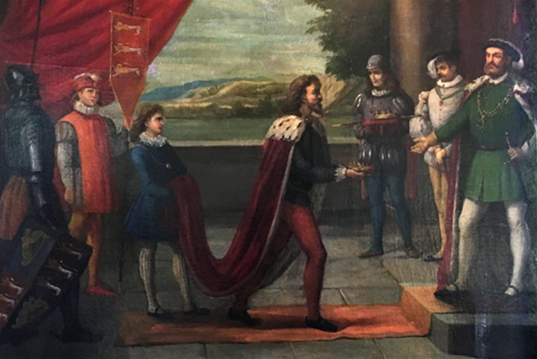Image: Murrough O'Brien, King of Thomond, Submits to King Henry VIII
Description: The O'Brien (Ó Briain) dynasty, kings of Munster, Ireland, was founded in the 10th century by w:Brian Boru who by conquest became High King of Ireland. Brian's descendants thus carried the name Ó Briain, continuing to rule the Kingdom of Munster until the 12th century when their territory had shrunk to the Principality of Thomond. The last Ó Briain to reign in Thomond was Murrough Ó Briain (d.1551) who surrendered his sovereignty to the new Kingdom of Ireland under the rule of King Henry VIII of England, being created instead (1543) w:Earl of Thomond and maintaining a role in governance. To show this resignation of the Gaelic Order and showing loyalty to the new king and government, the old heraldic arms (A dexter forearm grasping a sword in pale proper) (per The Chief Herald of Ireland’s office) were discarded (but retained as a crest) and King Henry VIII granted to Murrough his own personal arms of Plantagenet, differenced by tincture of the lions (party per pale or and argent) and by the absence of armed and langued azure (O'Brien, Donough, History of the O'Briens from Brian Boroimhe, AD. 1000 to AD. 1945, London, 1949, pp.50-54 & 198). "From an English point of view this was a great honor, but to the Ui Briain Clan, the Irish, and the Gaelic Order, it was surrender and defeat" (Garry Bryant / Garaidh Ó Briain, O'Brien Clan Heraldry, History of O’Brien Clan Heraldry, (Irish Armiger, 1992) [1]). At Dromoland Castle, there is an oil painting of the ceremony which took place at Greenwich on the terrace which overlooked the Thames. Henry VIII is seen with officials in attendance and gentlemen of the Court. Murrough King of Thomond is seen advancing towards him, his crown on a cushion, which he proffers to the new Tudor King of Ireland. His nephew Donough O'Brien who became second Earl of Thomond on Murrough's death, is in attendance on his uncle a few steps behind him. He and his bearer carry the banner newly granted, blazing the three Lions passant rampant, half argent and half or, distinguishing it from the Royal Arms of England, which has three similar lions, "or" only. It seems that the fully armed knight at left has lowered the old Gaelic shield (showing Irish harps in the 1st and 4th quarters - imaginary) to the ground in a gesture of despondency and shame. This right to use the royal arms so altered, and wear the royal liveries were accorded to the O'Briens then, and even as late as the first Jubilee of Queen Victoria in AD. 1887 and her subsequent Jubilee in 1897 the Lord Inchiquin of the day attended the Cere-monials at Parliament and Buckingham Palace in a large barouche with coachman and servant in royal liveries. Times have changed and these habits are a thing of the past. There is an ancient Bill in existence, showing that Crimson robes were especially ordered for Murrough O'Brien to wear at the Ceremony at Greenwich. "Bill for payment for the Lords of Ireland, of my Lordship "of Norfolk's commandment, for them to use at the Ceremony, "including Crimson velvet for robes and hood for the great Abreen "(O'Brien)." It is a curious fact that there was such a dearth of money in Ireland at the time, that the lord deputy, St. Ledger, had been obliged to lend to Murrough O'Brien £100, in harp-groats i.e. in pence to pay for his journey to London.[1]
Title: Murrough O'Brien, King of Thomond, Submits to King Henry VIII
Credit: History of the O'Briens from Brian Boroimhe, AD. 1000 to AD. 1945, page 264, https://archive.org/details/historyofobriens00obri/page/n309/mode/2up
Author: Unknown authorUnknown author
Usage Terms: Public domain
License: Public domain
Attribution Required?: No
Image usage
The following page links to this image:


